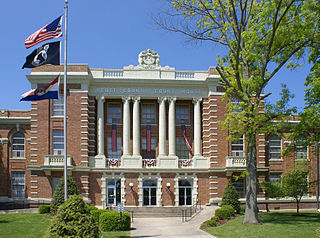
Eads Bridge is a combined road and railway bridge over the Mississippi River connecting the cities of St. Louis, Missouri and East St. Louis, Illinois. It is located on the St. Louis riverfront between Laclede's Landing, to the north, and the grounds of the Gateway Arch, to the south. The bridge is named for its designer and builder, James Buchanan Eads.

The Missouri State Capitol is the building that houses the legislative and executive branches of the government of the U.S. state of Missouri, as well as the Missouri General Assembly. Located in Jefferson City at 201 West Capitol Avenue, it is the third capitol in the city after the other two were demolished when they were damaged in fires. The domed building, designed by the New York City architectural firm of Tracy and Swartwout, was completed in 1917.

St. Louis Union Station, a National Historic Landmark, was a passenger intercity train terminal in St. Louis, Missouri. Once the world's largest and busiest train station, it was converted in the early 1980s into a hotel, shopping center, and entertainment complex. Today, an adjacent station serves light-rail passengers on MetroLink's Red and Blue Lines, while the city's intercity train station sits a quarter-mile to the east.

This is a list of properties and historic districts in Missouri on the National Register of Historic Places. There are NRHP listings in all of Missouri's 114 counties and the one independent city of St. Louis.

Sergeant Floyd is a historic museum boat, serving as the Sergeant Floyd River Museum & Welcome Center at 1000 Larsen Park Road in Sioux City, Iowa. Built in 1932 as a utility vehicle and towboat, she is one of a small number of surviving vessels built specifically for the United States Army Corps of Engineers in its management of the nation's inland waterways. The boat has been restored and drydocked, and now houses exhibits about the Missouri River and local tourism information. The museum is a facility of the Sioux City Public Museum.

The Dr. Generous Henderson House is a historic home located at 1016 The Paseo, once one of the most prestigious areas of Kansas City, Missouri.
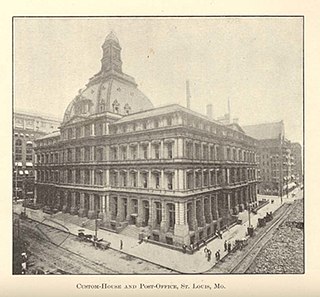
The U.S. Custom House and Post Office is a court house at 815 Olive Street in downtown St. Louis, Missouri.

Sanborn Field is an agricultural experiment field, located on the University of Missouri campus in Columbia, Missouri. Established in 1888, it was the first facility in the United States intended to measure erosion and run-off for differing crops and agricultural practices. Work at Sanborn Field was influential in the establishment of soil conservation policy in the United States. The field was designated a National Historic Landmark in 1964.

Graham Cave is a Native American archeological site near Mineola, Missouri in Montgomery County in the hills above the Loutre River. It is located in the 356 acre Graham Cave State Park. The entrance of the sandstone cave forms a broad arch 120 feet (37 m) wide and 16 feet (5 m) high. Extending about 100 feet (30 m) into the hillside, the cave protects an historically important Pre-Columbian archaeological site from the ancient Dalton and Archaic period dating back to as early as 10,000 years ago.

Downtown Columbia is the central business, government, and social core of Columbia, Missouri and the Columbia Metropolitan Area. Three colleges — the University of Missouri, Stephens College, and Columbia College — all border the area. Downtown Columbia is an area of approximately one square mile surrounded by the University of Missouri on the south, Stephens College to the east, and Columbia College on the north. The area serves as Columbia's financial and business district and is the topic of a large initiative to draw tourism, which includes plans to capitalize on the area's historic architecture and Bohemian characteristics. The downtown skyline is relatively low and is dominated by the 10-story Tiger Hotel, built in 1928, and the 15-story Paquin Tower.
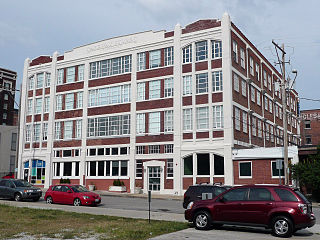
The Safeway Stores Office and Warehouse Building is a historic building near downtown Kansas City, Missouri. The building was designed by Kansas City architects Archer and Gloyd and was built by local contractor J. H. Thompson in 1929. It served as Safeway's regional produce and canned goods warehouse, as well as the regional headquarters for the chain. The warehouse served a region extending from Topeka, Kansas in the west to St. Joseph, Missouri in the north, Columbia, Missouri in the east to Joplin, Missouri in the south.

The North Ninth Street Historic District is a national historic district located at Downtown Columbia, Missouri, USA. It encompasses seven contributing buildings in an area that has historically been a center of commerce, recreation and culture. They were built between about 1885 and 1954, and are the L.J. Slate Billiard Hall, Allen Arnold Building, A. Victor Building, Lafayette Hume Building, Varsity Theatre (1927), Crosswhite Bakery, and Hume Building. The popular music venue The Blue Note is located within the district.

Campbell Chapel African Methodist Episcopal Church is a historic African Methodist Episcopal church located at 602 Commerce Street in Glasgow, Howard County, Missouri. It was built in 1865, and is a small one-story, vernacular brick building with simple Greek Revival style design elements. The rectangular building measures 32 feet by 52 feet and features a stepped gable and six brick pilasters.

Glasgow Presbyterian Church, also known as Glasgow Community Museum, is a historic Presbyterian church located at Commerce and 4th Streets in Glasgow, Howard County, Missouri. It was built in 1860-1861, and is a one-story, brick building with simple Gothic Revival style design elements. The rectangular building measures 57 feet, 5 inches, by 37 feet, 3 inches, and features a board-and-batten vestibule and a Gothic arcade supported by brick pillars. It houses a local history museum.
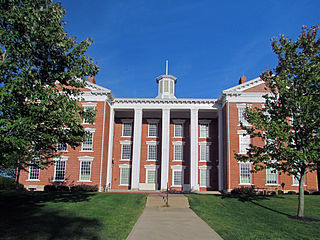
Jewell Hall is a historic building located on the campus of William Jewell College at Liberty, Clay County, Missouri. It was built between 1850 and 1853, and is a three-story, modified "H"-plan, Classical Revival style brick and Missouri limestone building. The building measures 120 feet in length and 66 feet in width. It features a colonnade of square columns which spans a recessed, central portico. The interior of Jewell Hall was completely remodelled in 1946-1948.
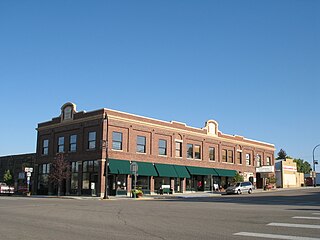
Commerce Block is a commercial building in Glenrock, Wyoming, built in 1917 during the Wyoming oil boom of the early 20th century. The nearby Big Muddy oil field brought prosperity to Glenrock, stimulating the growth of the town's commercial district. The building was built for the Glenrock Investment Company, a consortium of local investors, by Edward R. Reavill. The building housed the Glenrock State Bank until 1934. Other businesses in the building included a bar, a billiard parlor and a drug store. The Empress Theater took a two-story space in the east wing of the block. By the late 1920s the oil boom had ended and the theater passed through several owners, closing intermittently. In 1939 it was renamed the Wyoma Theater and had a prominent marquee.

Opera Hall Block, also known as the Farmers State Bank and Citizens National Bank Building, is a historic opera house and commercial block located at King City, Gentry County, Missouri. It was built in 1895, and is a 2 1/2-story, rectangular, Romanesque Revival style brick building. It measures 50 feet by 110 feet, and features a corner oriel window.

Quincy Public Hall, also known as the Quincy City Hall and Quincy Community Building , is a historic city hall located at Quincy, Hickory County, Missouri. It was completed in 1917, the hall is a one-story frame building measuring 45 feet by 26 feet. It sits on a flat stone foundation and has a high gable roof. It features a concrete entrance porch sheltered by a belfry supported by hand hewn wooden posts. The building serves as the center of the social, religious, educational, and civic structure of the hamlet of Quincy.

City Hall is a historic city hall located at Forest City, Holt County, Missouri. It was built in 1901, and is a two-story, rectangular red brick building measuring 80 feet by 40 feet. It sits on a foundation of smoothed and coursed native limestone blocks. It features a square clock tower.

The Lawrence County Bank Building is a historic bank building located at 100 West Commercial Street in Pierce City, Lawrence County, Missouri.



